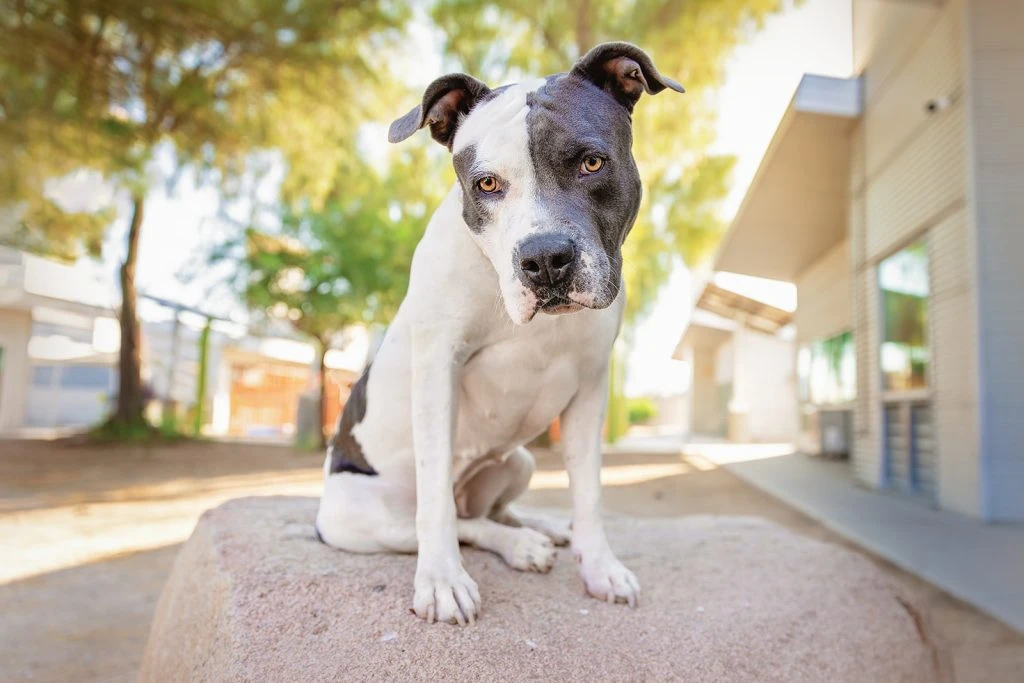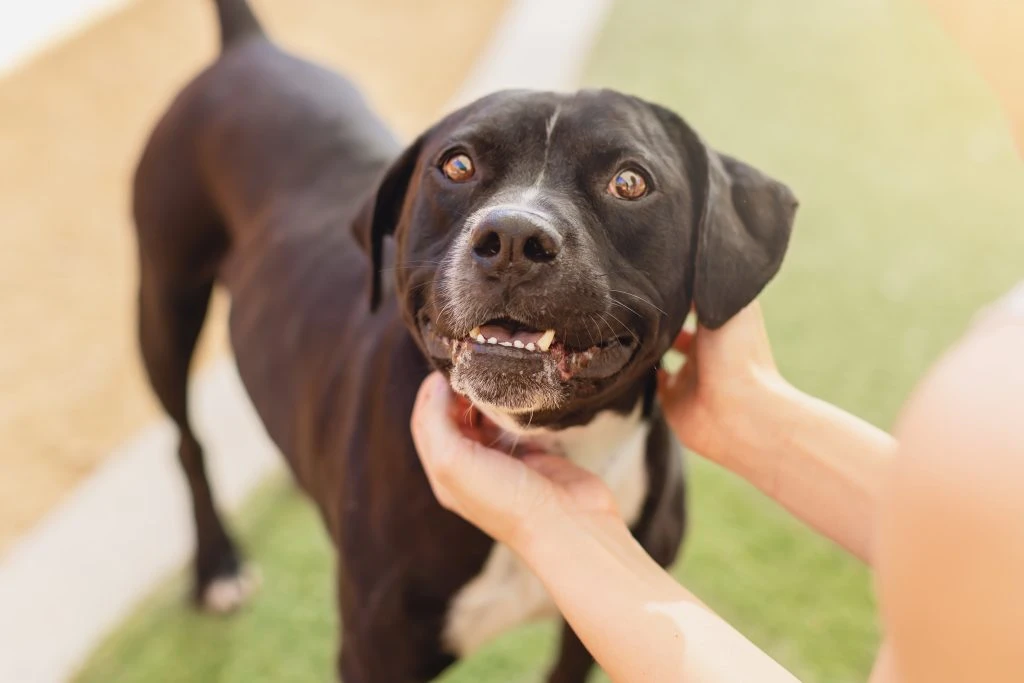Since 1978, The Animal Foundation has been a lifeline for animals in need, taking in more than 25,000 animals a year. As the largest single-site shelter in the country, we work tirelessly to provide care, find homes, and keep animals safe.
But our shelter is constantly at or near capacity. Overcrowding increases stress, impacts safety, and raises the risk of illness and behavioral decline in animals. That’s where our At-Risk Program comes in.
What is the At-Risk Program?
The At-Risk Program provides intervention for animals that are at risk of euthanasia because of treatable medical or behavioral challenges that could improve in a home setting.
We created this program to increase transparency between us (the shelter) and the community and to better advocate for the pets who urgently need placement. We are in a chronic space crisis and have been facing increasingly difficult euthanasia decisions, but our goal, just like yours, is to save as many lives as possible.
When an animal is identified as “at-risk,” they will be added to the report below so community members wanting to help can see all animals in need in one place. Our teams have a list of interventions that are implemented on a case-by-case basis to help animals while they wait to be fostered, adopted, or transferred. When these interventions fail or an animal is mentally or medically suffering, a commitment date may be added for the animal.
What is a commitment date?
A commitment date is a designated date by which an animal urgently needs placement outside the shelter due to severe medical or behavioral challenges. These are given when an animal is experiencing significant suffering that cannot be alleviated within the shelter environment.
Commitment dates serve as a critical call to action for adopters, fosters, and rescue partners, signaling that the animal needs immediate intervention to have a chance at a better outcome.
Our goal is always to give every animal the best possible chance, and commitment dates help rally our community to step in when time is running out. While there are times when an animal improves due to our interventions and the commitment date can be removed or extended, a commitment date often ends in the animal being humanely euthanized if they are not removed from the shelter environment.
Animals in this report without banners are listed for transfer due to medical or behavioral concerns but may also be available for adoption or foster. While they are not currently classified as At-Risk or Urgent, their need for placement becomes more pressing the longer they remain in the shelter. All behavior-listed dogs without banners are eligible for foster, while foster availability for medical cases varies.

How We Help At-Risk Animals
At The Animal Foundation, every At-Risk animal is closely monitored and evaluated by our Case Rounds Investigative Group (CRIG)—a dedicated team of leaders from every department, including animal welfare, adoptions, foster, transfer, volunteer services, veterinary services, marketing, and admissions. This diverse group brings their unique expertise together to ensure that every animal in need receives the best possible intervention and individual plans for every animal.
The CRIG team conducts daily shelter rounds, assessing each animal’s well-being and identifying those who require immediate attention. Our goal is to find solutions as quickly as possible, whether through medical care, behavioral support, or urgent placement efforts.
To give At-Risk animals the best chance at a positive outcome, we:
- Increase enrichment and training to help reduce stress and improve behavior
- Target foster and rescue placements for animals struggling in the shelter environment
- Update photos and biographies to generate more adoption interest
- Leverage social media and news coverage to expand visibility
- Evaluate medical treatments and stress-reducing interventions to improve quality of life
Despite our best efforts, there are times when animals have serious medical conditions we can’t treat in a shelter setting or behavioral concerns we cannot address. There are certain behaviors that make placement unsafe for the community. When an animal is suffering or poses a risk to the community, humane euthanasia may be considered as a last resort.
There will always be a need for humane euthanasia in our community, but our commitment remains the same: to save as many lives as possible while ensuring the best outcome for every animal in our care.
How You Can Help At-Risk Animals
The Animal Foundation is committed to doing everything possible to help At-Risk animals, but we can’t do it alone. The key to saving more lives is you—our community. Whether you adopt, foster, volunteer, or spread the word, your actions make a direct impact on these animals’ futures.
Adopt an At-Risk Animal
The best way to save a life is to adopt. If you’re interested, visit our shelter in person—no appointment needed.
- First-come, first-served adoptions are available Tuesday through Sunday, 11 AM – 7 PM (Closed Mondays).
- Our team will provide full behavioral and medical information and help facilitate a meet-and-greet.
- While we do not facilitate meetings with your current pets, we will provide step-by-step guidance on introducing a new pet to your home.
Foster an At-Risk Animal
Fostering provides an At-Risk animal with a temporary home, relieving shelter stress and increasing their chances of adoption.
- Visit the shelter anytime during adoption hours (Tuesday-Sunday, 11 AM – 7 PM).
- Our Foster Team (located at the window in the adoptions lobby) can help match you with an animal in need.
- If you prefer to schedule an appointment, email foster@animalfoundation.com.
- A current foster application must be on file before fostering. You can submit one here.
Other Ways to Help
One of the simplest yet most powerful things you can do is encourage others to adopt. Spread the word that shelter pets are just as loving, deserving, and wonderful as any other pet. Help educate your community on the dangers of backyard breeders and why adoption saves lives.
If you can’t bring an animal home, you can still help improve their quality of life while they’re in our care. Volunteers play a critical role in keeping shelter pets happy and engaged. Some ways you can help include:
- Providing enrichment by passing out peanut butter-filled Kongs for dogs or toys for cats
- Spending time with animals to help reduce stress and improve their socialization
- Helping update pet bios and photos to increase their chances of adoption
Every day, our team works hard to keep animals comfortable, engaged, and happy. You can support them by purchasing much-needed items from our Amazon Wishlist, which is updated regularly with our most urgent needs.
- One of our biggest ongoing needs? Peanut butter. We go through tens of thousands of jars every year providing enrichment to shelter dogs, helping them stay mentally stimulated and preventing behavioral decline.
- Shop Our Amazon Wishlist
Every action—big or small—makes a difference. Whether you adopt, foster, volunteer, advocate, or donate, you are helping to save lives. Thank you for being part of the solution.
Frequently Asked Questions
Unfortunately, more kennels does not always equate to more lives saved. The more animals there are in a shelter, the more chaos and stress there is. This in turn weakens their immune systems, making them susceptible to a decreased quality of life and illnesses that they would normally be able to shake.
The simple answer is that we work with a multitude of shelters and rescues every day and transfer several pets a week to other organizations. Unfortunately, shelters and rescues across the country are facing the same space crisis we are and are limited in how many pets they can transfer into their care. This crisis is affecting animal welfare organizations everywhere, and shelters like ours are sending pleas daily. If you have a direct connection with a rescue or shelter, please reach out; we’d love to expand our network.

